Summary
April 30, 1864, Clash at Whitten's Mill
The Route
▷ We previously began at Jenkins' Ferry, ending on Arkansas 46 at the Arkansas 291 junction, which is our starting point.
▷ Arkansas 46 at Arkansas 291There are two markers at this intersection, "Refugee Children" and "Supplies Destroyed". Turn left (initally west then northward) for 6.2 miles.
▷ Arkansas 291 at US 270 in PrattsvilleWhitten's Mill was near Prattsville. There are two markers at the Community Center. Return along Arkansas 291 to Arkansas 46.
▷ Arkansas 291 at Arkansas 46, Grant County ARTurn left (northeastward) on Arkansas 46 for 8.6 miles into Sheridan.
▷ Arkansas 46 at Shackleford Street, Sheridan ARAt Shackleford Street, turn left (northward) for about 0.2 mile to the Grant County Museum.
▷ Grant County Museum, Sheridan ARReturn to Arkansas 46.
▷ Shackleford Street at Arkansas 46, Sheridan ARTurn left (northeastward) onto Arkansas 46 for 1 mile
▷ Arkansas 46 at US 270/W Center St, Sheridan ARSheridan AR.
▷ This prepares us for traveling to the next point of interest, Little Rock.
Google Maps
Show my location on map
At the popup, you must allow your web brower (not us) to know your location.
Your location should update every 5 seconds.
This prepares us for traveling to the next point of interest, Little Rock.
Refugee Children Marker
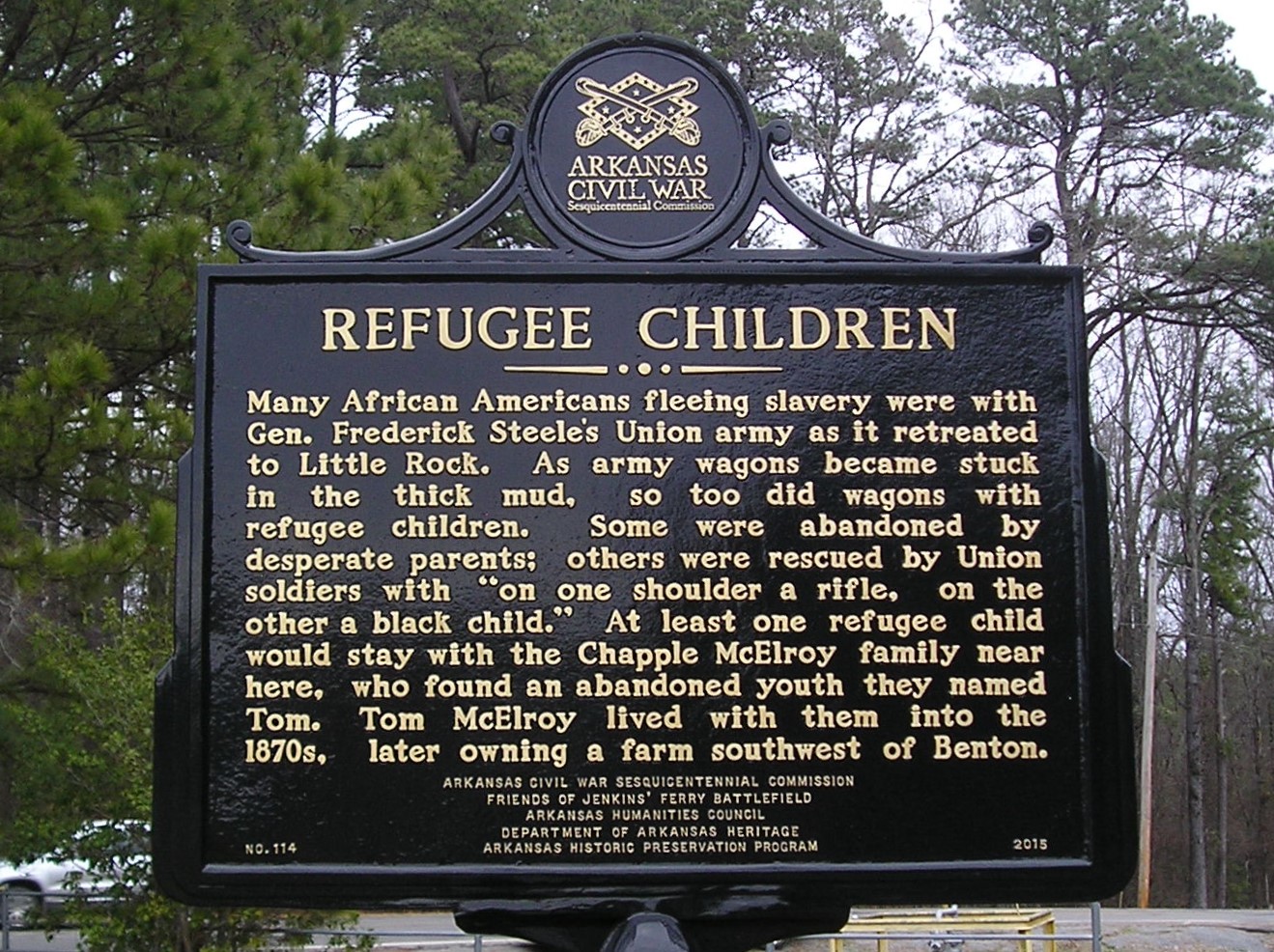
Runaway slaves attached themselves to the Union wagon train and were often so desperate that they abandoned their children.
Many African Americans fleeing slavery were with Gen. Frederick Steele's Union army as it retreated to Little Rock. As army wagons became stuck in the thick mud, so too did wagons with refugee children. Some were abandoned by desperate parents; others were rescued by Union soldiers with "on one shoulder a rifle, on the other a black child". At least one refugee child would stay with the Chapple McElroy family near here, who found an abandoned youth they named Tom. Tom McElroy lived with them into the 1870s, later owning a farm southwest of Benton.
Born in Kentucky in 1817, Chapple McElroy was in his late forties at the time of the Camden Expedition. A farmer of modest means in then Saline County, now Grant County, during the Civil War, he had a large family, had lost his first wife in 1861 and had already married his second wife in 1863 when he and his family found Tom in the spring of 1864. Tom was with them in the 1870 census, and he was listed as black. His age was given as eight years old, so he was probably two or three when he joined this white family. The census-taker without comment drew a line between him and the white McElroy children who preceded him in the 1870 census. Chapple McElroy died in 1875, and Tom may have left the family at that time. Whether he ever knew his birth parents is not known. Tom's story is but one example of the varied and devastating human costs of the Civil War.
Photo by Peggy Lloyd
Supplies Destroyed Marker
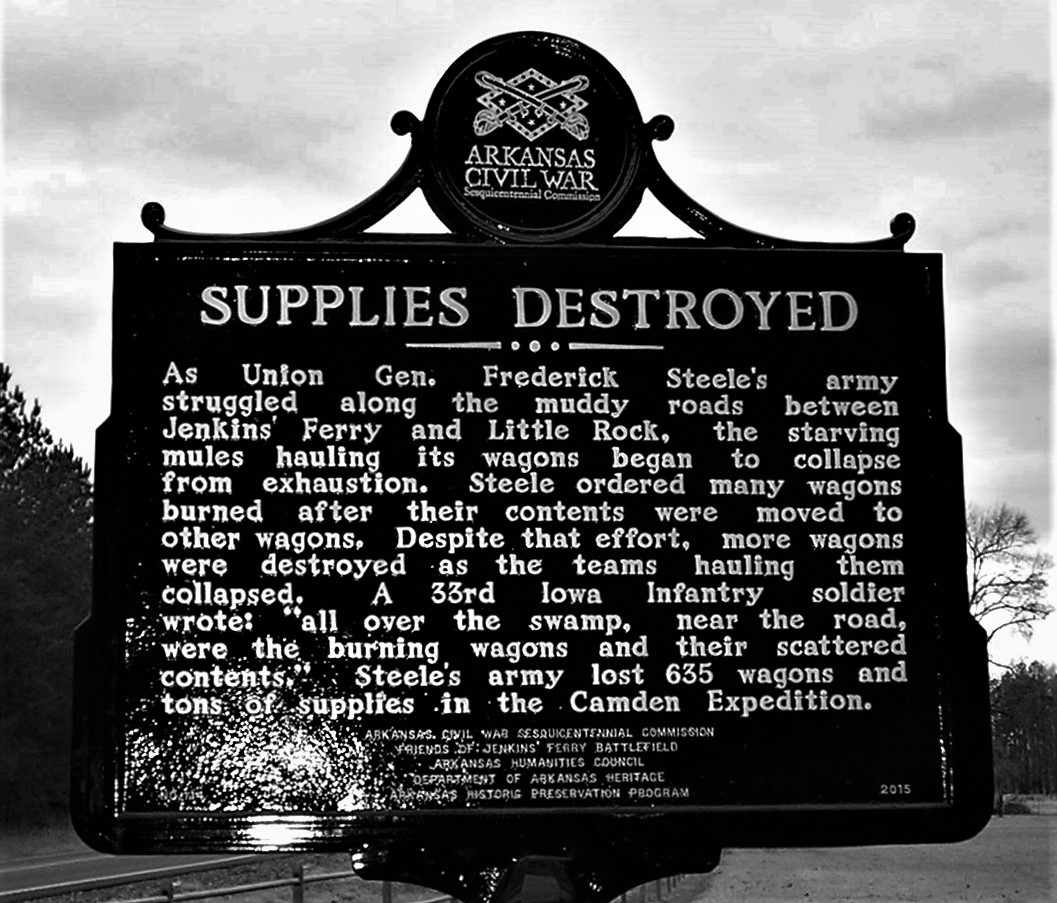
The loss of valuable supplies and equipment was another result of the Camden Expedition for the Union Army.
As Union Gen. Frederick Steele's army struggled along the muddy roads between Jenkins' Ferry and Little Rock, the starving mules hauling its wagons began to collapse from exhaustion. Steele ordered many wagons burned after their contents were moved to other wagons. Despite that effort, more wagons were destroyed as the teams hauling them collapsed. A 33rd Iowa Infantry soldier wrote: "All over the swamp, near the road, were the burning wagons and their scattered contents." Steele's army lost 635 wagons and tons of supplies in the Camden Expedition.
Not only were lives lost but also valuable equipment and supplies were wasted and left as part of a trail of destruction on the road to Little Rock. And for what purpose? The Camden Expedition was an ill-conceived plan that ended in disaster as was the entire Red River Campaign. Southwest Arkansas would remain in Confederate hands until the end of the war.
Photo by Peggy Lloyd
Prattsville
Prattsville is a small town in Grant County. Although not incorporated until 1962, it existed as a community at the time of the Civil War and had gotten a post office in 1857. The post office took the name Prattsville from John Pratt, the first postmaster and the operator of Pratt's Ferry on the Saline River west of the town. Significant fighting occurred in the vicinity between the Union and Confederate forces as General Frederick Steele retreated toward Little Rock with his army in the last few days of the Camden Expedition.
Clash at Whitten's Mill Marker
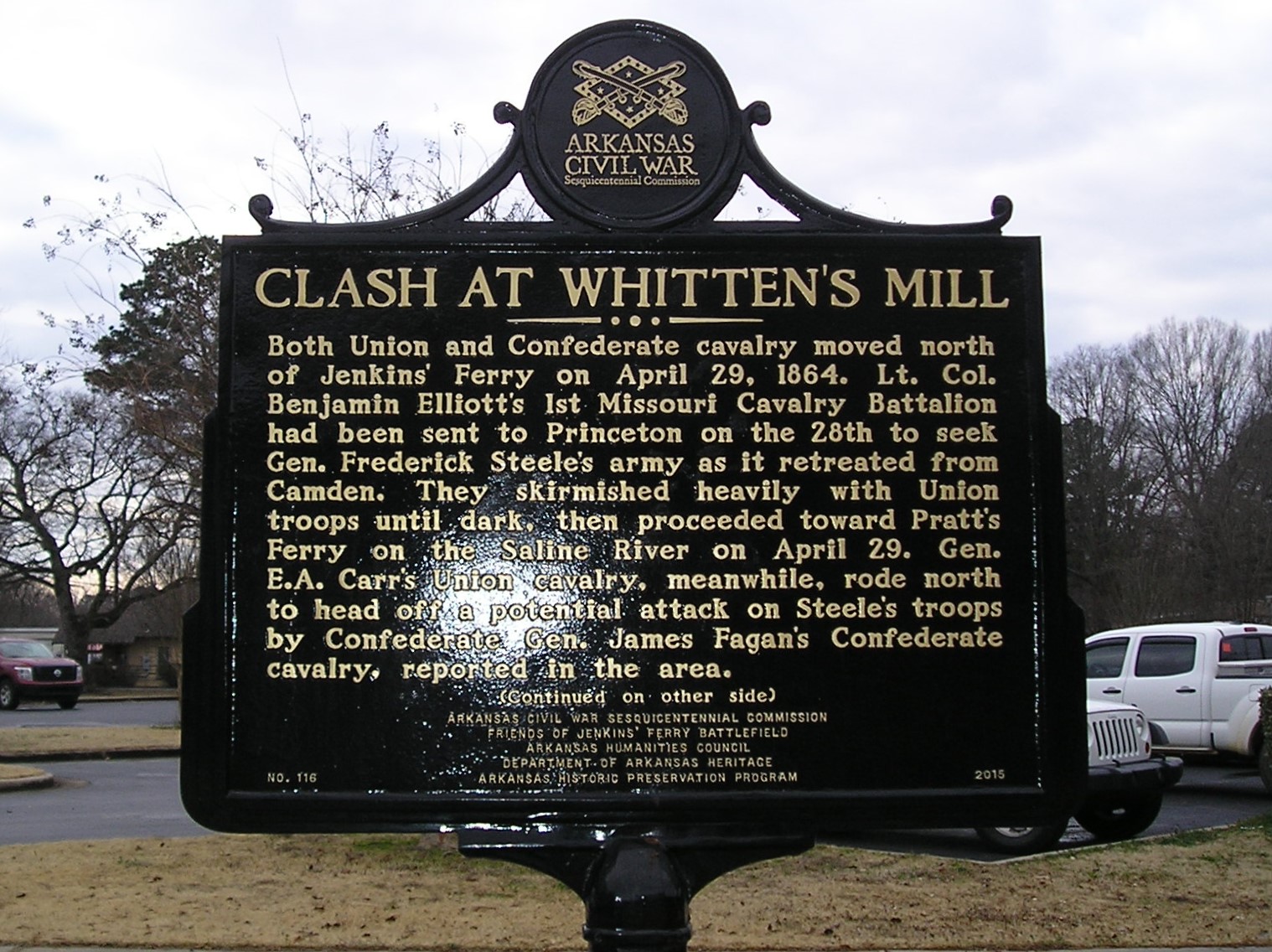
The Union Army erroneously referred to the site of the fighting as "Whitmore's Mill". The owner of the mill was actually a man named David Whitten, but both the names Whitten's Mill and Whitmore's Mill are used to refer to the skirmish.
Both Union and Confederate cavalry moved north of Jenkins' Ferry on April 29, 1864. Lt. Col. Benjamin Elliott's 1st Missouri Cavalry Battalion had been sent to Princeton on the 28th to seek Gen. Frederick Steele's army as it retreated from Camden. They skirmished heavily with Union troops until dark, then proceeded toward Pratt's Ferry on the Saline River on April 29. Gen. E. A. Carr's Union cavalry, meanwhile, rode north to head off a potential attack on Steele's troops by Confederate Gen. James Fagan's cavalry, reported in the area.
Clash at Whitten's Mill
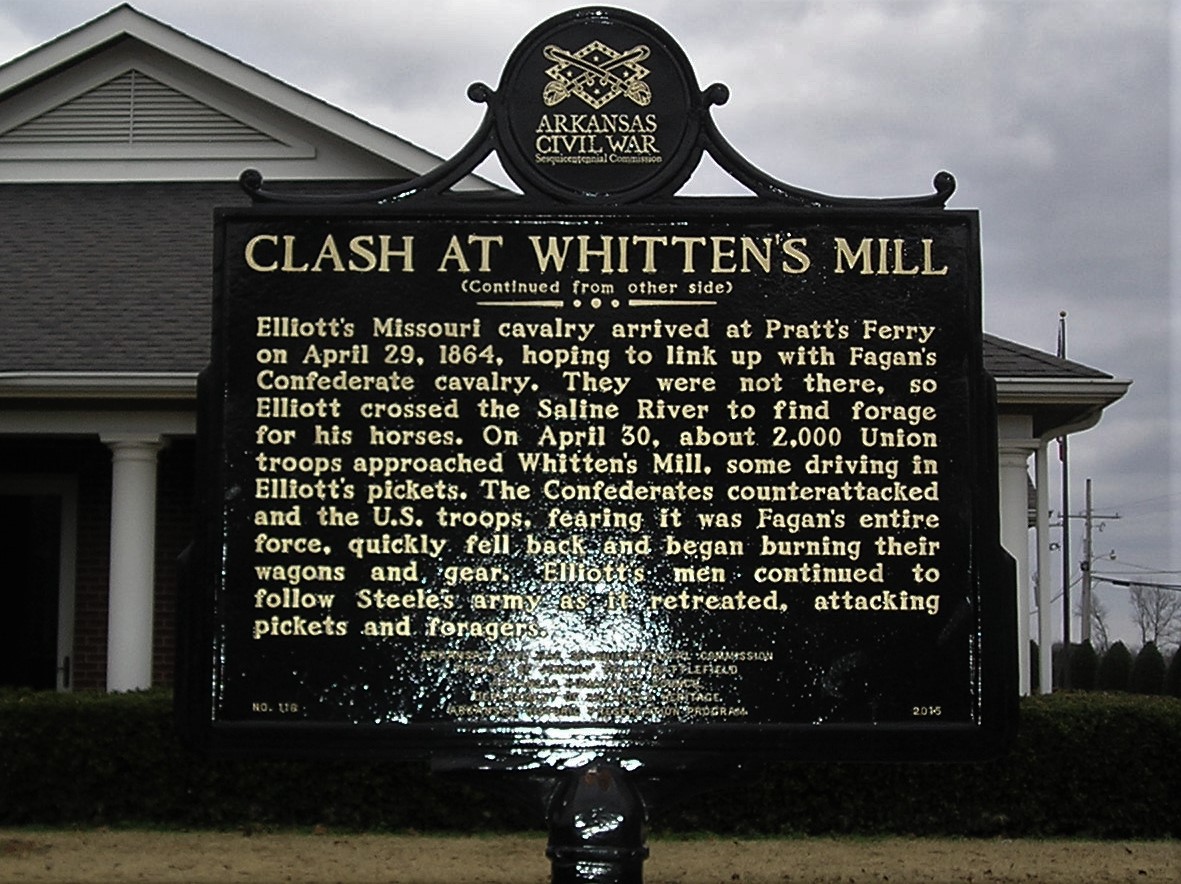
Elliott's Missouri cavalry arrived at Pratt's Ferry on April 29, 1864, hoping to link up with Fagan's Confederate cavalry. They were not there, so Elliott crossed the Saline River to find forage for his horses. On April 30, about 2,000 Union troops approached Whitten's Mill, some driving in Elliott's pickets. The Confederates counterattacked and the U. S. troops, fearing it was Fagan's entire force, quickly fell back and began burning their wagons and gear. Elliott's men continued to follow Steele's army as it retreated, attacking pickets and foragers.
Commentary
Gen. Steele had sent Gen. E. A. Carr and his troops, his vanguard force, ahead to scout the road to Little Rock and to bring help and supplies if possible while Steele himself monitored the crossing of the Saline by his wagon train and oversaw the defense mounted by his rearguard commanded by Salomon and Rice. The burning of wagons and supplies by both Steele's and Carr's men was to enable the troops to move faster on muddy, difficult roads if pursued by Confederates and to keep valuable equipment and supplies out of Confederate hands.
Grant County and Sheridan
The Byway proceeds through Grant County to Sheridan. Grant County did not exist at the time of the Civil War. The Arkansas Reconstruction legislature created the county from parts of Saline, Hot Spring and Jefferson counties on Feb. 4, 1869, and named it in honor of U. S. Grant, then the president-elect of the United States. The town of Sheridan was incorporated in 1887 and has since served as the county seat of Grant County. It was named for Phillip Sheridan, a highly successful Union officer in the Civil War who attained the rank of major-general.
Grant County Museum
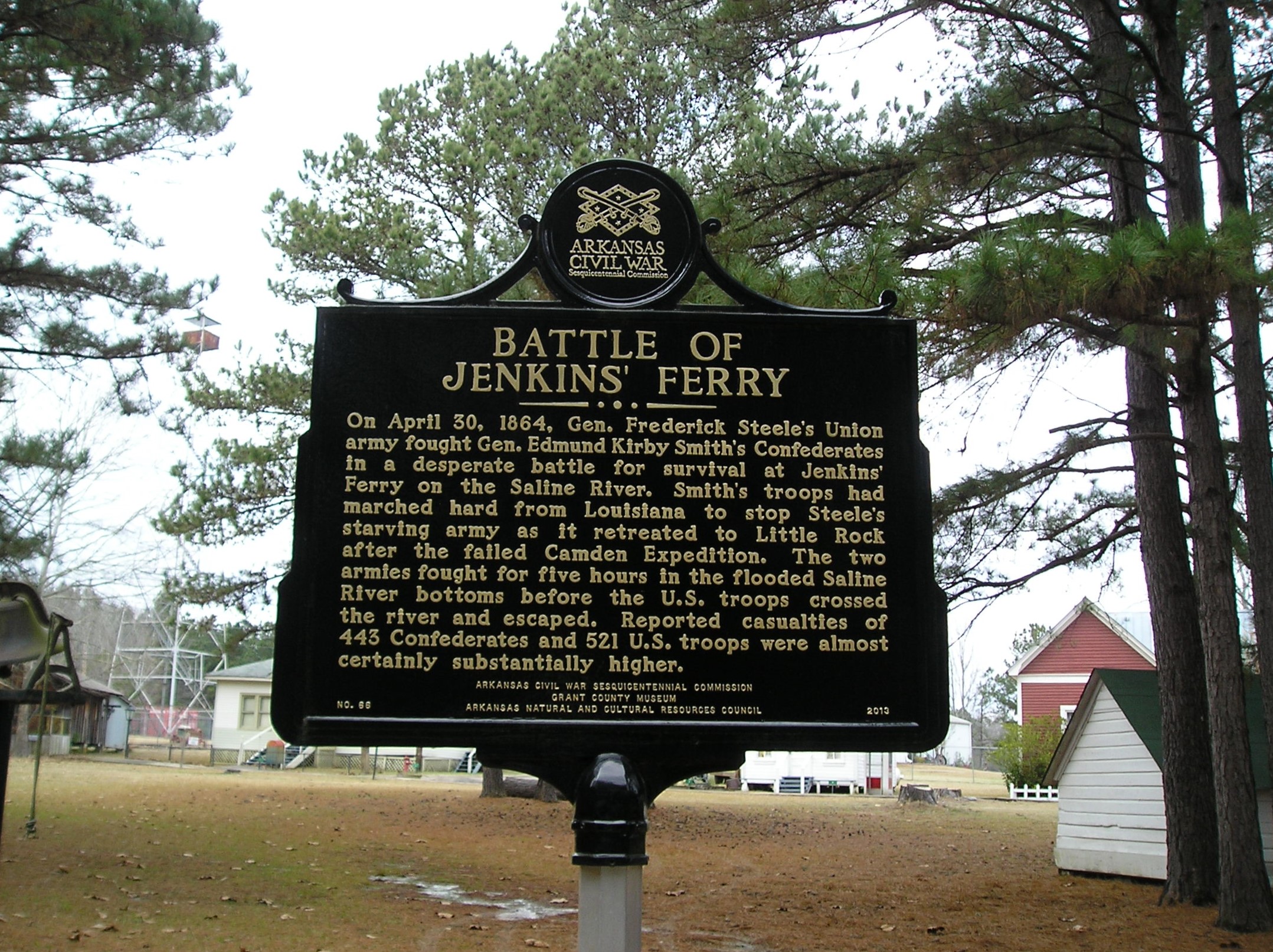
On April 30, 1864, Gen. Frederick Steele's Union army fought Gen. Edmund Kirby Smith's Confederates in a desperate battle for survival at Jenkins Ferry on the Saline River. Smith's troops had marched hard from Louisiana to stop Steele's starving army as it retreated to Little Rock after the failed Camden Expedition. The two armies fought for five hours in the flooded Saline River bottoms before U.S. troops crossed the river and escaped. Reported casualties of 443 Confederates and 521 U.S. troops were almost certainly substantially higher.
The Grant County Museum, located at 521 Shackleford Road just north of Arkansas 46 on the west side of Sheridan, is an unusually large local history museum with a variety of exhibits that include the Civil War and the Battle of Jenkins' Ferry. A Civil War Sesquicentennial marker stands in an outdoor collection of vintage buildings beside the museum. It summarizes this last major event of the Camden Expedition. The Museum is open from 9 to 4 from Monday to Friday. It also features a 700-foot boardwalk completed in 2008 through forest land on the three-acre grounds of the museum.
Photo by Peggy Lloyd
Up Next
This prepares us for traveling to the next point of interest, Little Rock.


